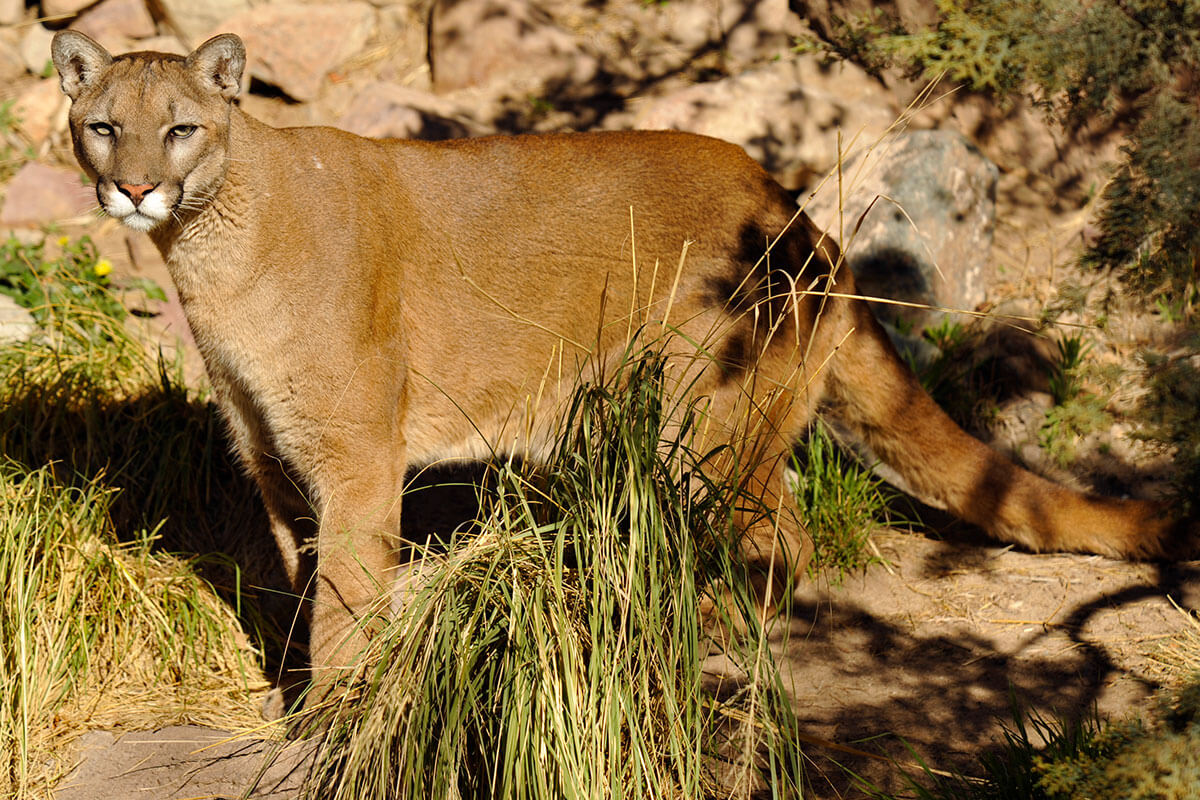Mountain Lions

The mountain lion, also known as a cougar, puma, and Florida panther, is a large, unspotted cat with a relatively small head and a long, dark-tipped tail. Once, the mountain lion had one of the most extensive distributions of all American terrestrial mammals. It ranged from coast to coast in North America, and from southern Argentina to northern British Columbia. Hunting and environmental changes have restricted their range to relatively mountainous, unpopulated areas.
Endangered Status
Two subspecies of the mountain lion are on the U.S. Endangered Species List; the eastern puma (reports issued by the U.S. Fish and Wildlife Service in 2011 and 2015, concluded that the eastern cougar was extinct and recommended the subspecies be removed from the U.S. endangered species list) and the Florida panther (the Florida panther is categorized as critically endangered, with less than 100 individuals surviving in the wild).
Because the mountain lion requires game-rich wilderness, it has declined or been exterminated from where it once thrived early in the 20th century. Its habitat has been overtaken by development in many areas, and its main prey, the white-tailed deer, disappeared over much of its range.
For many years, this large wildcat was pursued by bounty hunters and persecuted as a threat to livestock. There have been a few sightings of the animal or its tracks in Canada’s Maritime Provinces, upper New England, New York state, and elsewhere in the East in recent years, but most reports have turned out to be false. Radio-tracking is being used to study the behavior of Florida panthers, and an office has been established to investigate reports of eastern puma sightings in the southern Appalachians.
Currently, the species is full protected where rare, and classified as a game animal where abundant.
Physical Attributes
- Mountain lions weight: 75 – 275 LBS (34 – 125 kg); Body length is 6' – 9' (1.5 – 2.75 meters); Tail is between 21" – 37" (53 – 92 cm) long.
- The mountain lion is large and slender.
- Fur has a short and course texture.
- General coloration ranges from a yellowish brown to grayish brown on the upper parts and a paler, almost buffy, color on the belly.
- Throat and chest are whitish.
- The mountain lion has a pinkish nose, with a black border that extends to the lips.
- Muzzle stripes, the area behind the ears, and the tip of the tail are black.
- Eyes of mature animals are grayish brown to golden.
- The tail is long, cylindrical, and about one-third of the animal’s total length.
- Feet are broad, with 4 digits on hind feet and 5 on forefeet. The retractile claws are sharp and curved.
- The skull of the mountain lion is noticeably broad and short. The forehead region is high and arched.
Food
The mountain lion is essentially a carnivore. It eats moose, elk, white-tailed deer, caribou and smaller creatures like voles, squirrels, mice, muskrat, porcupine, beaver, raccoon, striped skunk, coyote, birds, and even snails and fish when necessary. They have developed a taste for poultry, calves, sheep, colts, and pigs.
Mountain lions have a distinctive manner of hunting larger prey. The lion maneuvers to within 15 feet of the prey, then leaps on its back and breaks the animal’s neck with a powerful bite below the base of the skull. Yearly food consumption is between 1,900 – 2,900 LBS (860 – 1,300 kg) of large prey animals.
Parenthood
Females usually give birth every other year, and litters vary in size from 1 to 6 cubs, with an average of 3 or 4. Birth weight is between 0.5 – 1 LB (226 – 453 grams). The cubs open their eyes 10 days after birth. At the same time their ear pinnate unfolds, their first teeth erupt, and they begin play. They are fully weaned at about 40 days of age. The newborn cubs, heavily spotted for the first three months of life, are raised only by the female. At about 3 months, the young are weaned and begin hunting with the mother. Mother and young, who remain together for about a year and a half, communicate by licking, rubbing and vocalizing.
Behavior & Habitat
Mountain lions are solitary animals, except during the breeding season and during a period of juvenile dependence. Males are found together immediately after leaving their mother, but rarely as established adults. Population densities vary from as low as 1 per 85 square kilometers to as high as 1 per 13 to 54 square kilometers. These mammals space themselves so that local food supplies and other essentials are not depleted. Females with dependent cubs live within the wide space used by the resident male. Resident males mark their territories by scratching trees and depositing urine or fecal materials by those tree. The mountain lion is primarily nocturnal in its activity.
The mountain lion vocalizes with low-pitched hisses, growls, and purrs. The loud, chirping whistle by the young serves to direct the mother’s attention to the cut. The mountain lion summers and winters in different locations, migrating between the ranges.
Mountain lions can be found in a wide range of habitats, including mountain coniferous forests, lowland tropical forests, grassland, dry brush country, swamps, and any areas with adequate cover and prey. Dense vegetation, caves, and rocky crevices serve as temporary shelter places.
Beware!
The most widely distributed cat in the Americas (found from Canada to Argentina), the mountain lion is a solitary, strongly territorial hunting species. Unlike most cats, it hunts day or night, although it generally chooses to hunt at night in populated areas to avoid humans.
Occasionally, mountain lions have been known to injure or even kill people, usually children, but they tend to avoid humans unless cornered or extremely hungry.
References:
- “Mountain Lion”, Nature and Wildlife database eNature.com
- The University of Michigan Museum of Zoology Animal Diversity Web
